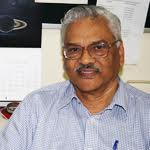
The ASI announces, with sadness, the passing away of Dr. G.S.D. Babu, a former Secretary of the ASI.
Dr. Babu, an alumnus of the Osmania University did his M.Sc from the Department of Astronomy in 1966, after which he was at the then U.P. State Observatory (now ARIES), Nanital for a decade (1966-1976). He then joined the Indian Institute of Astrophysics (IIA) in 1978, mainly working in the area of stars and star clusters. He obtained his Ph.D. in 1987 from the Bangalore University. He was the Scientist-in-charge of the Vainu Bappu Observatory (VBO) during 1998-2003. Dr. Babu also served as the Director of the J.N. Planetarium, Bengaluru during 1992-1993. Post superannuation from IIA in 2003, he served as the Director of the M.P. Birla Institute of Fundamental Research, Bengaluru.
Dr. Babu was one of the first three Indian astronomers, who carried out a solar astronomy programme at the permanent Indian station, Maitri in Antarctica during the 1989-90 expedition. He also participated in the month-long expedition to the island country of Mauritius for the photometric observations of the Supernova 1987A as the leader of the IIA expedition team in 1988. He was a member of the Standing Advisory Committee of the Positional Astronomy Centre, Kolkata for several years.
Dr. Babu was the Secretary of the ASI during 1995-1997.
Dr. G.S.D. Babu passed away on 18th October 2023 at the age of 80 years. A passionate science communicator and an excellent singer, Dr. Babu will be missed by all. On behalf of the ASI, the ASI-EC conveys its condolences to the bereaved family members.
-----------------------------------------------------------
By Dr. G. C. Anupama on behalf of ASI-EC
----------------------------------------------------------
Dr Gondi Samuel Devadarana Babu will be remembered as an observational astronomer with keen interest in instrumentation and techniques of observations. He was also interested in the history of astronomy and had developed schemes for outreach activities.
After his elementary education in Nandyal, AP, he pursued his Masters in Astronomy from the Osmania University, Hyderabad. He got introduced to observational techniques and handling telescopes. He remembers the revered teachers he had there. He joined the Uttar Pradesh State Observatory and carried on the observations of variable stars and comets. The comet West (1976) fascinated him in particular. With limited set up of instruments he devised a method of getting the effective temperatures of stars with observations of continua along the spectra.
Dr Babu joined the Indian Institute of Astrophysics in 1977 to extend the determination of effective temperatures of ‘peculiar A’ stars. These are now renamed as chemically peculiar stars, with subscripts to identify sub classification. He used the new instrument called scanner designed by Prof Vainu Bappu for this purpose. We had determined the temperatures of more than 125 stars. One of them HD34452 showed a periodic variation in the continuum itself.
In order to work at the limiting magnitudes of the 1m telescope a camera had to be designed with minimum number of optical elements. The objective grating spectrograph was designed for this purpose, tested and calibrated by Dr Babu. The stars with tails of spectra recorded on small photographic plates were declared ‘text book’ quality by Prof Bappu. Dr Babu used this set up which bore his name for identification, for his work on galactic open clusters. That fetched him his doctorate from the Bangalore University.
The experience with observing comets got him included to the team for observing comet Halley for its 1985-86 apparition by prof K R Sivaraman. The development of the molecules in the tail were monitored for more than 10 months. Dr Babu continued his work with other comets as well. A rare opportunity was waiting for Dr Babu; he made a trip to Antarctica and carried out routine observations of the site survey, the sun and stars from there.
Dr Babu was the Director of the Jawaharlal Nehru Planetarium, during 1992-93. He initiated many outreach activities like short interactive sessions for children one of which had the astronaut Rakesh Sharma talking to students. He also organised several exhibitions. The comet Swift- Tuttle was observed from the small 6” coude telescope of the Planetarium, for which he got several accessories like the platform for ease of observation. The staff remember his magic of bringing the comet from ‘nowhere’ into the field of view.
Dr Babu served as the resident astronomer at the Kavalur Observatory before joining the Birla Institute of Fundamental Research where he initiated many outreach activities. The 100 - hour astronomy programme was received with great enthusiasm by the student community of Bengaluru. His skills as a good teacher and science communicator were used for this programme very effectively. He continued his research on open clusters and carried out observations from the CREST facility too. He was an active member of the ASI and served as the secretary.
Dr Babu had initiated work on the observation with the 18th century instruments of Jai Singh at Delhi and Jaipur. He was also interested in music and was a great singer. The 1m telescope dome echoed his songs through the night of observations.
His demise has saddened many of his students and admirers, many of whom had the privilege of getting a pat from him and proceed towards research in astrophysics.
------------------------------------------------------
By Dr. B. S. Shylaja
------------------------------------------------------
